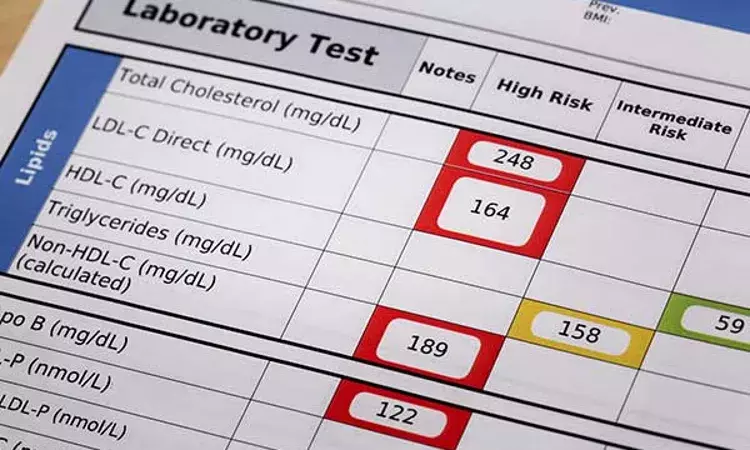- Home
- Medical news & Guidelines
- Anesthesiology
- Cardiology and CTVS
- Critical Care
- Dentistry
- Dermatology
- Diabetes and Endocrinology
- ENT
- Gastroenterology
- Medicine
- Nephrology
- Neurology
- Obstretics-Gynaecology
- Oncology
- Ophthalmology
- Orthopaedics
- Pediatrics-Neonatology
- Psychiatry
- Pulmonology
- Radiology
- Surgery
- Urology
- Laboratory Medicine
- Diet
- Nursing
- Paramedical
- Physiotherapy
- Health news
- Fact Check
- Bone Health Fact Check
- Brain Health Fact Check
- Cancer Related Fact Check
- Child Care Fact Check
- Dental and oral health fact check
- Diabetes and metabolic health fact check
- Diet and Nutrition Fact Check
- Eye and ENT Care Fact Check
- Fitness fact check
- Gut health fact check
- Heart health fact check
- Kidney health fact check
- Medical education fact check
- Men's health fact check
- Respiratory fact check
- Skin and hair care fact check
- Vaccine and Immunization fact check
- Women's health fact check
- AYUSH
- State News
- Andaman and Nicobar Islands
- Andhra Pradesh
- Arunachal Pradesh
- Assam
- Bihar
- Chandigarh
- Chattisgarh
- Dadra and Nagar Haveli
- Daman and Diu
- Delhi
- Goa
- Gujarat
- Haryana
- Himachal Pradesh
- Jammu & Kashmir
- Jharkhand
- Karnataka
- Kerala
- Ladakh
- Lakshadweep
- Madhya Pradesh
- Maharashtra
- Manipur
- Meghalaya
- Mizoram
- Nagaland
- Odisha
- Puducherry
- Punjab
- Rajasthan
- Sikkim
- Tamil Nadu
- Telangana
- Tripura
- Uttar Pradesh
- Uttrakhand
- West Bengal
- Medical Education
- Industry
High Non-HDL-C Levels in Adolescents tied to CAC in Mid-adulthood

Biological processes underlying the causes of heart disease begin years before the emergence of clinical symptoms. In a recent study published in the JAMA Cardiology on January 27, 2021, researchers have reported that the elevated Non–high-density lipoprotein cholesterol (non-HDL-C) levels at all stages of life are associated with Coronary Atherosclerosis in mid-adulthood. They further reported that the elevated non-HDL-C levels in adolescents may indicate the presence of Coronary Artery Calcification (CAC) in mid-adulthood. They recommend greater awareness of the importance of elevated non–HDL-C among adolescence.
Low-density lipoprotein cholesterol (LDL-C) is an important risk factor for heart disease and is the primary target in the management of adult dyslipidemia. The non–HDL-C encompasses a greater number of atherogenic lipids and lipoproteins. It might provide a better marker of heart disease risk attributable to dyslipidemia. Elevated non–HDL-C is associated with the presence of coronary artery calcification (CAC), a marker of heart disease in adulthood. Yet, the relative importance of non–HDL-C levels at different life stages for predicting atherosclerotic disease in later life remains unclear. Therefore, Dr Matthew K. Armstrong and colleagues conducted a study, to identify the relative association of non-HDL-C measured at distinct life stages (adolescence, young adulthood, mid-adulthood) with the presence of CAC measured in mid-adulthood.
The Cardiovascular Risk in Young Finns Study was a multicenter, population-based cohort study that began in 1980 with subsequent follow-up in 1983, 1986, 1989, 1992, 2001, and 2007. Researchers analyzed the data of 589 participants from this 28 years study by February 2020. They noted the non-HDL-C levels at 3 life stages including adolescence (aged 12-18 years), young adulthood (aged 21-30 years), and mid-adulthood (aged 33-45 years). In 2008, CAC was determined using computed tomography. Researchers categorized the CAC as 0 (no CAC, Agatston score = 0) or 1 (presence of CAC, Agatston score ≥1) for the purpose of analysis. They used Bayesian relevant life course exposure model to determine the relative association between non–HDL-C at each life stage and the presence of CAC in mid-adulthood.
Key findings of the study were:
• Researchers adjusted the model for year of birth, sex, body mass index, systolic blood pressure, blood glucose level, smoking status, lipid-lowering and antihypertensive medication use, and family history of heart disease.
• They noted that the cumulative exposure to non–HDL-C across all life stages was associated with CAC (odds ratio [OR], 1.50).
• They found that the ORs of CAC presence due to elevated non–HDL-C exposure during young adulthood and mid-adulthood were 1.14 and 1.12, respectively.
• However, they noted that exposure to non–HDL-C during adolescence had the strongest association—with an OR of 1.16 (95%, 1.01-1.46).
The authors concluded, "These data suggest that elevated non–HDL-C levels at all life stages are associated with coronary atherosclerosis in mid-adulthood. However, adolescent non–HDL-C levels showed the strongest association with the presence of CAC in mid-adulthood".
They further added, "Altogether, early screening, identification, and management of elevated non–HDL-C levels may represent an important goal toward reducing the burden of heart disease in adulthood".
For further information:
https://jamanetwork.com/journals/jamacardiology/fullarticle/2775672
Medical Dialogues Bureau consists of a team of passionate medical/scientific writers, led by doctors and healthcare researchers. Our team efforts to bring you updated and timely news about the important happenings of the medical and healthcare sector. Our editorial team can be reached at editorial@medicaldialogues.in.
Dr Kamal Kant Kohli-MBBS, DTCD- a chest specialist with more than 30 years of practice and a flair for writing clinical articles, Dr Kamal Kant Kohli joined Medical Dialogues as a Chief Editor of Medical News. Besides writing articles, as an editor, he proofreads and verifies all the medical content published on Medical Dialogues including those coming from journals, studies,medical conferences,guidelines etc. Email: drkohli@medicaldialogues.in. Contact no. 011-43720751


